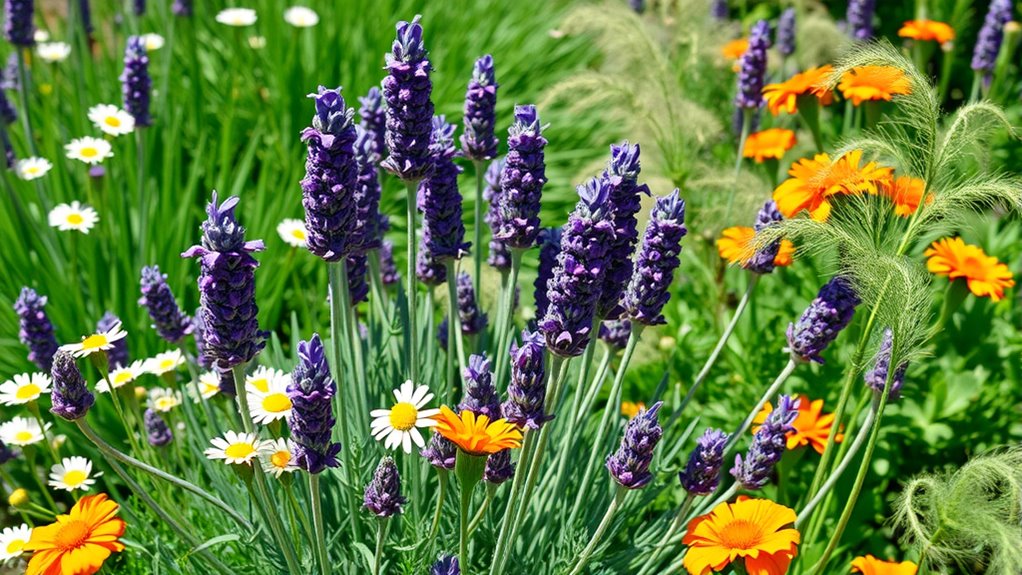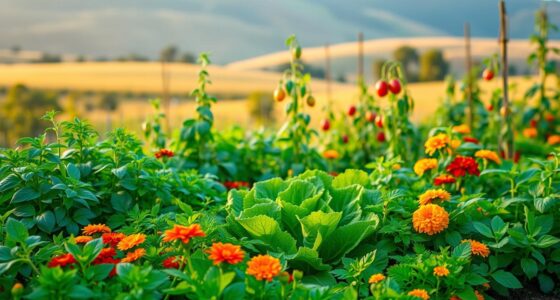To boost your lavender garden, consider planting herbs like rosemary, sage, and thyme, which thrive in similar conditions and help repel pests. Perennials like sedum, echinacea, and yarrow attract pollinators and improve soil health, supporting your plants’ growth. Adding marigolds and lavender cotton enhances pest control and visual appeal. Keep exploring to discover more companion plants that make your garden both beautiful and resilient.
Key Takeaways
- Plant rosemary and sage nearby to improve air circulation, repel pests, and enhance fragrance in lavender gardens.
- Incorporate drought-tolerant perennials like sedum and yarrow for low-maintenance, pollinator-friendly companions.
- Use marigolds and yarrow to naturally deter pests and attract beneficial insects, supporting organic pest control.
- Combine lavender with thyme and yarrow to promote healthy growth, pollination, and garden biodiversity.
- Select plants with similar soil and sunlight needs, such as lavender with rosemary and sedum, for optimal growth.
Rosemary
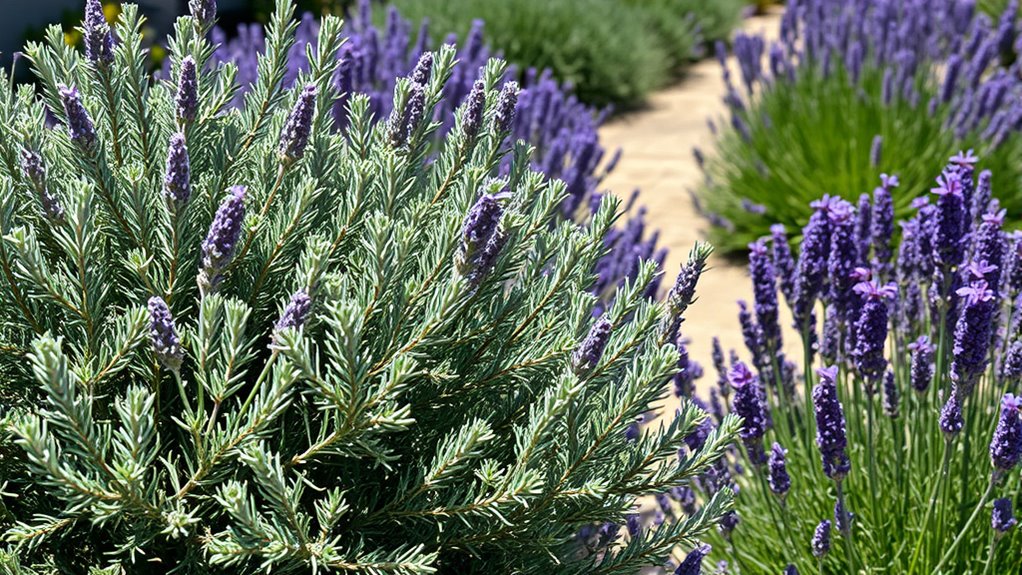
Rosemary makes an excellent companion plant for lavender because both thrive in similar growing conditions. They prefer well-draining soil and lots of sunlight, making them ideal partners in your garden. Planting rosemary nearby can help improve air circulation around your lavender, reducing the risk of fungal diseases. Rosemary’s upright growth habit contrasts nicely with lavender’s bushy form, creating an attractive display. Additionally, rosemary attracts beneficial insects like pollinators, which can boost the overall health of your garden ecosystem. Both plants are drought-tolerant once established, so they require minimal watering, making them low-maintenance choices. Keep in mind that rosemary can sometimes become invasive if not managed, so give it enough space. Using companion planting strategies can help optimize growth and health for both plants. Proper soil preparation ensures that both plants thrive and remain healthy. Overall, combining rosemary with lavender creates a fragrant, hardy, and visually appealing garden duo.
Sage

Sage and lavender grow well together, sharing similar soil and sunlight needs. Planting sage nearby can help repel pests that might target your lavender. Together, they create a resilient and healthy garden space. Incorporating companion plants like sage can also support plant health by promoting a balanced garden ecosystem. Additionally, sage’s aromatic properties can enhance the garden’s fragrance and overall atmosphere.
Growing Well Together
When planting lavender, pairing it with sage creates a mutually beneficial relationship that promotes healthy growth. Sage helps improve soil drainage and may deter pests, benefiting lavender’s delicate roots. Sage’s aromatic leaves can mask the scent of lavender from herbivores, reducing the risk of being eaten. Both plants thrive in similar conditions—well-drained soil, full sun, and low humidity—making them ideal companions. Their similar water needs prevent overwatering, which can harm either plant. This pairing also encourages biodiversity in your garden, attracting pollinators to both plants. To maximize benefits, plant sage nearby but ensure enough space for air circulation. Properly identifying and monitoring plant health can further enhance success, as signs of spoilage in companion plants can indicate environmental issues. Recognizing plant health indicators helps maintain optimal growing conditions. Regularly inspecting your plants helps prevent disease spread and keeps your garden thriving. This setup boosts plant vigor and creates a fragrant, low-maintenance garden space for you to enjoy.
Repels Pests Effectively
Because of its strong aromatic properties, sage effectively repels a variety of common garden pests that can threaten lavender. The scent confuses insects like aphids, moths, and beetles, preventing them from settling on your plants. Planting sage nearby creates a natural barrier, reducing the need for chemical controls. Imagine walking through your garden and noticing fewer pest issues on your lavender. To visualize how sage interacts with pests, consider this table:
| Pest | Effect of Sage |
|---|---|
| Aphids | Repelled by sage’s strong scent |
| Moths | Avoids areas with sage aroma |
| Beetles | Detours away from sage leaves |
| Whiteflies | Discouraged by sage’s aromatic properties |
Incorporate sage into your lavender garden for a pest-free, aromatic space, as understanding companion planting can maximize your garden’s health and productivity. Additionally, integrating natural pest repellents like sage can further reduce the need for chemical interventions. Using beneficial plants such as sage can also attract helpful insects that prey on pests, enhancing your garden’s ecological balance. Incorporating electric pest control tools can provide an extra layer of protection without harmful chemicals. Being aware of pest behavior patterns can help you better plan your pest management strategies.
Thyme

Thyme is an excellent companion for lavender because it attracts beneficial insects that help control pests and promotes healthy growth for both plants. When you plant thyme nearby, pollinators like bees and predatory insects are drawn to your garden, naturally managing pest populations. Additionally, thyme’s low-growing, spreading nature helps prevent weeds from taking over and improves soil drainage around lavender. Its aromatic foliage can also act as a natural deterrent for certain pests that might target lavender. By combining these two herbs, you create a mutually beneficial environment that enhances overall plant health.
- Encourages pollination, boosting lavender’s flowering
- Helps improve soil aeration and drainage
- Acts as a natural pest repellent for certain insects
Sedum
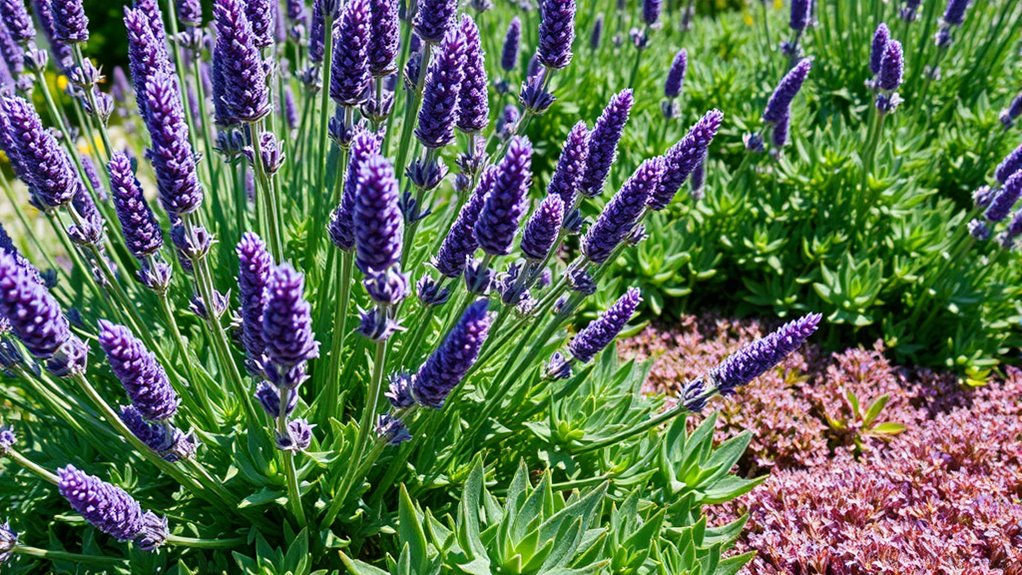
Sedum, also known as stonecrop, makes an excellent companion plant for lavender due to its drought-tolerant nature and low-growing habit. You’ll find that sedum thrives in well-drained soil and full sun, matching lavender’s preferences perfectly. Its succulent leaves store water, helping it withstand dry spells, and its compact growth creates a beautiful ground cover that doesn’t compete for space or nutrients. Plant sedum nearby to add texture and visual interest to your garden, while also promoting good airflow around your lavender. This pairing helps prevent fungal issues common in wetter conditions. Both plants require minimal watering once established, making them ideal partners for a low-maintenance, drought-resistant garden. Additionally, their compatibility in a virtual or real environment supports the idea of creating resilient, sustainable plant combinations. Together, they create a stunning, resilient display that blooms in harmony throughout the growing season. Incorporating plants with genetic variation can enhance garden biodiversity and resilience, contributing to a healthier ecosystem.
Echinacea

Echinacea, commonly known as coneflower, makes a vibrant companion for lavender. Its tall, daisy-like blooms add striking color and attract pollinators like bees and butterflies, benefiting both plants. Echinacea tolerates dry, well-drained soil, matching lavender’s needs and creating a low-maintenance pairing. Its deep-rooted structure helps prevent soil erosion and improves drainage, supporting healthy growth. Additionally, Echinacea’s medicinal properties make it a practical addition to your garden. When planted near lavender, they form a visually appealing and eco-friendly landscape that encourages pollination and supports local wildlife. This pairing creates a resilient, fragrant garden with sustained color and benefits that extend beyond aesthetics. Incorporating companion planting principles can further enhance garden sustainability and promote plant health. Utilizing plant compatibility strategies ensures both plants thrive together and maximize their ecological benefits. Proper cost management in garden planning can also optimize resource use and reduce expenses. Incorporate Echinacea to enhance your lavender garden’s beauty and ecological health.
Yarrow

Yarrow is a great companion for lavender because it helps repel pests naturally, keeping your garden healthier. Its bright blooms add a striking contrast, boosting your garden’s visual appeal. Plus, yarrow attracts pollinators, which support the overall growth and significance of your lavender plants. Additionally, incorporating plant diversity can improve the resilience of your garden ecosystem. Including plants like yarrow can also contribute to soil health by enhancing nutrient cycling and preventing erosion.
Pest Resistance Benefits
Yarrow is known for its ability to enhance pest resistance when planted alongside lavender. When you pair these plants, yarrow attracts beneficial insects like ladybugs and predatory wasps that prey on common lavender pests such as aphids and spider mites. This natural pest control reduces the need for chemical treatments. Additionally, yarrow’s aromatic leaves can repel certain harmful insects directly, creating a protective barrier around your lavender. Its presence also helps improve overall plant health, making lavender less vulnerable to pest infestations. Incorporating yarrow into your garden fosters a balanced ecosystem, encouraging beneficial insect populations. This synergy not only keeps pests at bay but also promotes thriving, healthy lavender plants. Overall, yarrow is a smart companion for pest-resistant lavender cultivation. This mutualistic relationship further enhances the resilience of your garden ecosystem, making it a sustainable and effective pest management strategy. Moreover, planting yarrow can contribute to garden biodiversity, supporting a variety of beneficial organisms that maintain healthy plant growth. Additionally, yarrow’s ability to improve soil health can further benefit lavender by enhancing nutrient availability and soil structure. Furthermore, yarrow’s deep roots help in soil aeration, which adds to the overall health of the soil environment supporting lavender growth. Engaging in companion planting with yarrow can also help reduce the need for chemical pesticides, promoting a more organic gardening approach.
Enhances Aesthetic Appeal
Pairing yarrow with lavender not only boosts pest resistance but also considerably enhances your garden’s visual appeal. Yarrow’s feathery, fern-like foliage creates a lush, textured backdrop that contrasts beautifully with lavender’s silvery-gray leaves and purple spikes. The bright, varied colors of yarrow, from yellow to red, add vibrant accents that brighten the garden. Their differing heights create a layered, dynamic look, making your planting beds more interesting. Yarrow blooms from late spring to fall, extending the flowering season alongside lavender. Together, they form a harmonious, colorful display that draws the eye and adds depth to your garden’s design. This pairing elevates both the aesthetic value and the overall charm of your outdoor space.
Supports Pollinator Activity
Have you noticed how yarrow attracts a variety of pollinators to your garden? Its flat-topped clusters of tiny flowers provide an easy landing platform, drawing bees, butterflies, and even beneficial insects. When you plant yarrow near lavender, you create a vibrant pollinator hub that boosts your garden’s health. These visitors help with pollination, ensuring better flower and seed production. Additionally, yarrow’s blooms extend the flowering season, offering food sources when other plants fade. This continuous supply of nectar encourages a diverse range of pollinators to stay active in your garden. Incorporating yarrow alongside lavender not only enhances beauty but also supports the essential pollinator activity that keeps your garden thriving.
- Attracts diverse pollinators, including bees and butterflies
- Extends blooming period for continuous nectar supply
- Promotes healthy pollination for nearby plants
Lavender Cotton

Lavender Cotton, with its soft gray-green foliage and delicate blooms, makes an excellent companion plant for lavender. Its low-growing, bushy habit creates a lovely ground cover that complements lavender’s vertical spikes. Both plants thrive in similar well-drained, sandy soils and full sun, making them ideal partners in your garden. Lavender Cotton’s drought tolerance and minimal watering needs align perfectly with lavender’s requirements, ensuring easy maintenance. Its silvery foliage adds a soft contrast to the purple hues of lavender, enhancing visual appeal. Additionally, Lavender Cotton’s aromatic leaves can help deter pests, offering a natural pest-repellent effect. Planting them together creates a harmonious, low-maintenance, and visually appealing setting that benefits both plants and your garden’s overall health.
Marigolds
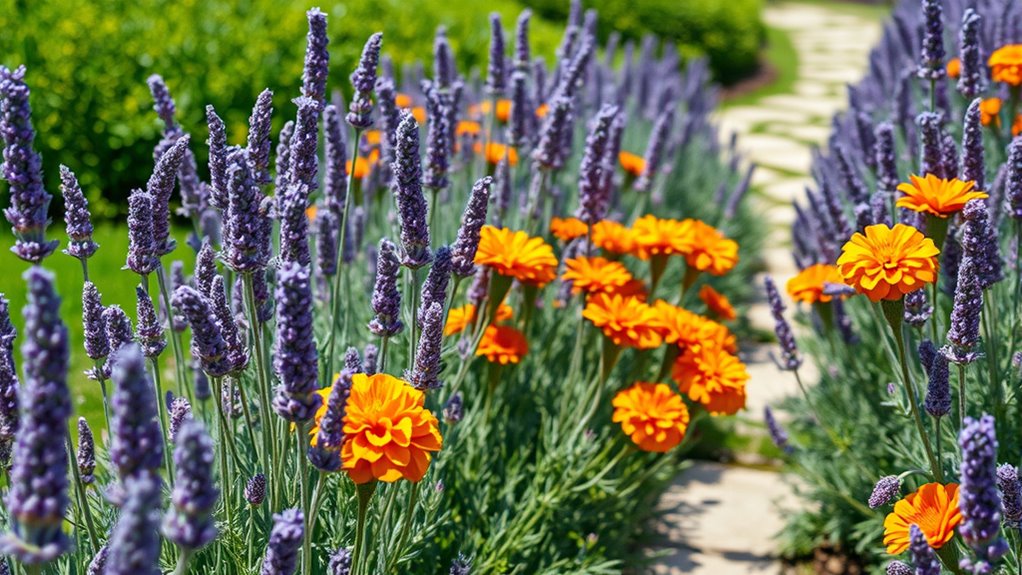
Marigolds bring vibrant color and natural pest control to a lavender garden, making them an excellent companion plant. Their bright blooms attract beneficial insects like ladybugs and hoverflies, which help keep pests away from your lavender. Plus, marigolds emit a scent that deters nematodes and aphids, protecting your plants without chemicals. You’ll enjoy a lively, pest-resistant garden with these cheerful flowers nearby. To maximize their benefits, consider planting marigolds in well-drained soil and full sun, ensuring they thrive alongside lavender. Regular deadheading encourages continuous blooming and maintains their vibrant appearance. Incorporate marigolds into your garden as border plants or intersperse them among your lavender to create a colorful, pest-free haven. Their resilience makes them a practical, attractive partner for your lavender.
Frequently Asked Questions
Can Lavender Be Planted With Vegetables?
You can plant lavender with vegetables, but it’s important to choose compatible types. Lavender thrives in well-drained soil and full sun, making it a great companion for certain vegetables like carrots, tomatoes, and lettuce. Its drought tolerance can help improve soil conditions, and its fragrant aroma may repel pests. Just make certain that you give lavender enough space and avoid overly rich soil, which can hinder its growth.
What Are the Best Soil Conditions for Lavender Companions?
You should guarantee the soil for your lavender companions is well-draining and slightly alkaline, with a pH between 6.5 and 7.5. Avoid heavy, clay soils that retain moisture, as lavender thrives in dry conditions. Incorporate sand or gravel to improve drainage, and add lime if your soil is too acidic. Proper soil conditions promote healthy growth and help your plants resist root rot and other issues.
How Do Companion Plants Affect Lavender’s Pest Resistance?
Companion plants can considerably boost lavender’s pest resistance by attracting beneficial insects like ladybugs and predatory wasps that prey on pests. When you plant companions such as marigolds or thyme nearby, they create a diverse environment that confuses pests and reduces infestations. You’ll notice fewer problems with pests because these plants naturally repel or attract enemies of common lavender pests, helping you maintain a healthy, pest-resistant lavender garden.
Are There Any Shade-Tolerant Plants Suitable With Lavender?
Imagine finding a perfect harmony in a garden—are there shade-tolerant plants that suit lavender? While lavender loves full sun, you can pair it with plants like ferns or hostas that thrive in partial shade. These companions add lush greenery without competing for sunlight. Though lavender prefers sun, combining it with shade-tolerant plants creates a balanced, visually appealing garden that thrives in varying light conditions.
Which Companion Plants Help Improve Lavender’s Growth Speed?
You want to know which plants can help lavender grow faster. To boost its growth, consider planting rosemary or thyme nearby. These herbs share similar soil and sunlight needs, creating a healthy environment for lavender. They also attract beneficial insects and improve soil quality. By choosing these companions, you’ll create a thriving garden where lavender can develop more quickly and stay healthy.
Conclusion
By pairing lavender with these plants, you’re creating a harmonious garden that’s as timeless as a Shakespearean sonnet. Think of rosemary and sage as your garden’s trusty knights, standing guard, while marigolds and yarrow add a splash of color and resilience. Just like an old-world apothecary, your garden becomes a fragrant tapestry of benefits. Embrace these companions, and your lavender will thrive, proving that good things really do grow when you nurture tradition alongside innovation.
